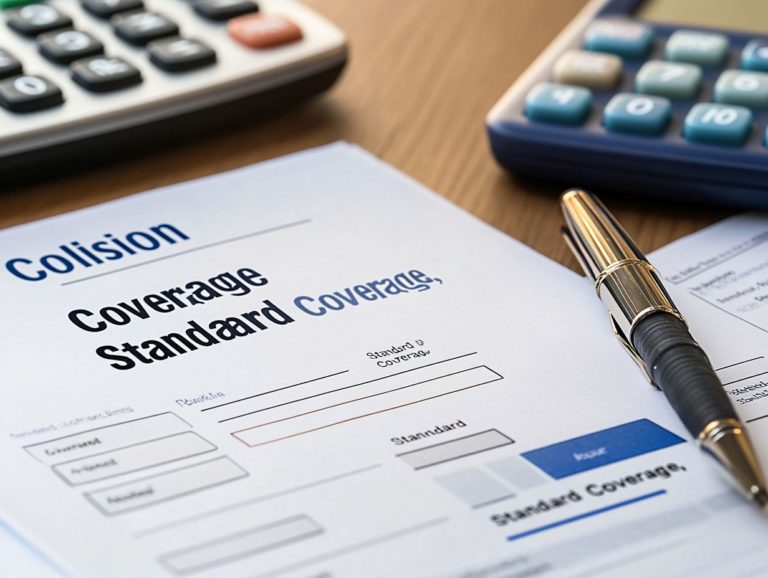5 Steps to a Comprehensive Insurance Comparison
Dealing with insurance can be tough, but understanding your options is essential for making informed financial decisions.
This guide will walk you through five vital steps to help you compare insurance policies with confidence. From identifying your specific needs to gathering quotes and assessing company reputations, it covers all the bases.
You ll also explore various types of insurance, key factors to keep in mind, and common pitfalls to sidestep. By the end, you ll gain the insights you need to make empowered choices about your coverage.
Contents
- Key Takeaways:
- 1. Determine Your Insurance Needs
- 2. Gather Quotes from Multiple Insurance Companies
- 3. Compare Coverage and Costs
- 4. Research the Insurance Company’s Reputation
- 5. Consider Additional Factors Before Making a Decision
- Types of Car Insurance Policies You Should Know About
- What Are the Key Factors to Consider When Choosing an Insurance Company?
- How Can One Save Money on Insurance?
- What Are the Common Mistakes to Avoid When Comparing Insurance?
- How Often Should One Review and Compare Their Insurance Policies?
- What Are the Benefits of Regularly Comparing Insurance Policies?
- Frequently Asked Questions
- What are the 5 steps to a comprehensive insurance comparison?
- Why is it important to research my options when comparing insurance?
- How do I understand my insurance needs?
- What should I compare when looking at insurance coverage and rates?
- Why should I read reviews and ratings before choosing an insurance policy?
- Is it possible to find a comprehensive insurance policy that fits my budget?
Key Takeaways:

- Determine your insurance needs before comparing policies to ensure you get the right coverage.
- Obtain quotes from multiple insurance companies to get a comprehensive view of available options.
- When comparing coverage and costs, consider both the benefits and drawbacks of each policy.
1. Determine Your Insurance Needs
To navigate the complex landscape of car insurance effectively, you should begin by identifying your unique insurance needs. Consider your financial situation and the types of coverage that align with your circumstances, such as collision coverage, comprehensive coverage, liability coverage, and gap insurance (which covers the difference between what you owe on your auto loan and the car’s current value) if you have an auto loan.
Understanding how different coverage types address distinct financial needs can make this process much simpler. For example, liability coverage is essential for protecting yourself against legal costs if you re deemed at fault in an accident. Comprehensive coverage offers protection from losses due to theft or natural disasters.
To assess your personal requirements, you can utilize various tools and calculators available on resources like the Insurance Information Institute. Check your vehicle’s age and resale value. Also, consider your driving habits to find the right coverage level, ensuring you achieve peace of mind and financial security in the face of unforeseen events.
2. Gather Quotes from Multiple Insurance Companies
Collecting insurance quotes from multiple car insurers is an essential step in finding the best auto insurance policy that fits your coverage needs and budget. By following 5 tips for comparing commercial auto insurance, you can gain the power to make informed premium comparisons.
To kick off the process, you can leverage various online tools designed for swiftly obtaining quotes. It’s vital to provide detailed and accurate information, such as your vehicle’s make and model, your driving history, and any previous insurance claims. Additionally, consider learning about 5 things you didn’t know about auto insurance comparisons to ensure that the quotes you receive truly reflect your unique situation.
As you assess your options, remember to look beyond the premiums; diving into the coverage details is crucial. Be sure to compare what you pay before insurance kicks in, the maximum amount insurance covers, and extra perks offered by the insurer. To help you navigate this process, consider these 5 ways to save money while comparing policies. These factors significantly influence your overall satisfaction with a policy, so take the time to scrutinize each option carefully.
3. Compare Coverage and Costs
To choose the most suitable car insurance policy, it’s essential to compare both coverage and costs. Focus on critical elements like collision and comprehensive coverage, and consider 5 things to know about comparing premiums, all while keeping your budget in mind.
Evaluating specific factors such as what you pay before insurance kicks in and policy limits is key to making an informed decision. Lower deductibles might mean higher premiums, while higher deductibles could lead to significant savings but may pose risks should an accident occur.
It s important to find the right balance between the overall cost of premiums and the level of coverage provided, as this can greatly affect your financial protection. Utilizing resources like consumer reports and insurance ratings can offer valuable insights into the various options available, helping you navigate the complexities of selecting the right policy with greater ease.
4. Research the Insurance Company’s Reputation

Researching the reputation of your chosen insurance companies is essential. Solid consumer reports and ratings from reputable agencies like A.M. Best, Fitch, Moody’s, and Standard & Poor’s can provide valuable insights into their reliability and customer service.
By looking into these reviews and ratings from diverse sources, you can gain a clearer picture of the financial stability and overall performance of potential insurance providers. This thorough examination reveals not only the claims experiences of other customers but also underscores the importance of securing a trustworthy insurance partner.
A reputable company protects your assets. It also improves your long-term financial health, offering peace of mind as you navigate the uncertainties of life.
5. Consider Additional Factors Before Making a Decision
Before you finalize your decision on a car insurance policy, don t miss out on these crucial factors. Look into the discounts available for safe driving, explore usage-based insurance options, and delve into insights from online reports that could influence your premium and coverage choices.
Bundled insurance offers can significantly reduce your costs when you coordinate multiple policies. Loyalty discounts reward your long-term commitment as a customer, providing extra financial relief. The rise of telematics the technology that tracks your driving habits through a device in your car can even lead to personalized premiums that reflect your actual behavior rather than mere assumptions.
Amidst these potential savings, remember that reading the fine print is essential. Understanding policy exclusions is crucial to avoid any unpleasant surprises down the road. What may initially seem like an attractive offer might come with limitations that don t align with your specific driving needs.
Types of Car Insurance Policies You Should Know About
When looking into car insurance, it’s essential for you to explore the myriad types of policies available:
- Collision coverage: Vital for those who frequently navigate bustling streets, it covers damages to your vehicle following an incident with another car or object.
- Comprehensive coverage: Provides peace of mind for vehicle owners in areas susceptible to natural disasters, vandalism, or theft, as it safeguards against damages beyond collisions.
- Liability coverage: Essential for drivers looking to protect themselves from legal claims arising from accidents where they are at fault.
- Gap insurance: Covers the difference between what you owe on your car and its current market value a scenario often encountered in states like California, where vehicle prices tend to soar.
Be aware that coverage requirements can vary by state. For example, regulations in Maryland and Massachusetts vary significantly, impacting minimum coverage requirements. This prompts you to make informed decisions about the insurance types that best suit your unique circumstances.
What Are the Key Factors to Consider When Choosing an Insurance Company?
Choosing the right insurance company requires you to evaluate several key factors, such as their insurance ratings, insights from consumer reports, and the overall financial health of the insurer each of which can significantly shape your insurance experience.
Pay attention to how quickly claims are processed. A prompt and efficient claims system can ease your stress during challenging times. The quality of customer service is also crucial; knowledgeable and responsive representatives can truly make a difference when navigating your coverage options.
It s essential to review the variety of coverage options available to ensure that your individual needs are met adequately. Additionally, verifying that your insurance provider complies with regulatory standards across different states is vital. This not only protects your interests but also establishes a reliable partnership for any unforeseen circumstances that may arise.
How Can One Save Money on Insurance?

You can save money on car insurance by using a few smart strategies. Start by taking advantage of safe driving discounts. Compare quotes from multiple insurers and understand the details of premium comparisons.
Consider bundling your car insurance with other policies, like home or renters insurance. This often leads to significant discounts. Maintaining a good credit score is also crucial; insurers frequently review credit histories to assess risk and set rates accordingly.
Shopping around for insurance options keeps you aware of competitive pricing. It also allows you to customize a policy that adapts to your changing needs. For a deeper exploration of maximizing your savings, check out tools and resources on websites like Bankrate and Investopedia. They offer invaluable insights and comparisons.
What Are the Common Mistakes to Avoid When Comparing Insurance?
When comparing car insurance, avoiding common mistakes can save you time and money. Watch out for pitfalls like neglecting to read the fine print on insurance quotes and failing to consider the full range of premium comparisons. For more insights, learn how to navigate the insurance comparison landscape across various insurance companies.
Many individuals mistakenly prioritize price above all else. This can lead to inadequate coverage and unexpected out-of-pocket expenses when an accident occurs. Overlooking customer service ratings may result in choosing a provider that is difficult to work with when it comes time to file claims. It s essential to evaluate the limitations of your coverage options to ensure that policy exclusions don t leave you vulnerable.
Engaging in a thorough review process, supported by insights from reputable consumer reports, can guide you toward decisions that prioritize both financial savings and comprehensive protection.
How Often Should One Review and Compare Their Insurance Policies?
Review your auto insurance policy regularly to ensure you’re getting the best value for your coverage needs. Ideally, do this annually or whenever significant life changes occur that might impact your insurance quotes.
For example, after renewing a policy or experiencing major events like moving to a new home or acquiring a new vehicle, reassessing your coverage can lead to unexpected savings and better options. These changes often shift your circumstances in ways that insurance companies consider when determining their quotes.
Utilizing premium comparisons can reveal various offers, helping you understand not just the costs but also the extent of coverage provided. By examining these factors closely and exploring 5 ways to use online tools for premium comparison, you can make informed decisions that align with your current situation and financial goals.
What Are the Benefits of Regularly Comparing Insurance Policies?
Comparing insurance policies regularly gives you amazing benefits, from ensuring optimal coverage to identifying better premium rates. It also safeguards your financial health by preventing overpayment for unnecessary coverage.
By actively engaging in this process, you can discover new discounts that may not have been available with your previous provider, leading to significant savings. Maintaining competitive pricing ensures that you re not left behind in a market that often fluctuates.
Adapting your coverage to match your current needs is essential, as life circumstances can change quickly. Having a policy that reflects those changes can prevent gaps in your protection.
Utilizing online comparison tools can greatly simplify this process, providing side-by-side evaluations of various options to help you find the best fit for your unique situation.
Frequently Asked Questions

What are the 5 steps to a comprehensive insurance comparison?
Here are the 5 steps to compare insurance: research your options, understand your needs, compare coverage and rates, read reviews and ratings, and choose the best policy for your budget.
Why is it important to research my options when comparing insurance?
Researching your options is crucial for finding the best insurance. By doing so, you can compare auto insurance quotes, companies, coverage options, and rates effectively.
How do I understand my insurance needs?
Understanding your insurance needs means evaluating your current coverage. Identify any gaps or risks and consider your budget.
What should I compare when looking at insurance coverage and rates?
When comparing insurance coverage, look at the types of coverage offered. To make informed decisions, understand how to compare auto insurance policies effectively by checking the limits, deductibles, and any extra benefits.
Why should I read reviews and ratings before choosing an insurance policy?
Reading reviews gives you insights into customer service and the claims process. This information helps you make a smart choice.
Is it possible to find a comprehensive insurance policy that fits my budget?
Absolutely! You can find an amazing insurance policy that won’t break the bank. Compare rates and coverage options to get the best value.






